Bewährte Verfahren und Strategien für indirektes Kategorienmanagement

Wenn Ihre indirekten Ausgaben unter dem Radar bleiben, sind Sie nicht allein und sie kosten mehr als Sie denken.
Indirektes Kategorienmanagement wird oft übersehen, doch es macht bis zu 40% der Gesamtausgaben eines Unternehmens und verbirgt zahlreiche Ineffizienzen. Verstreute Lieferanten, eigensinnige Einkäufe und mangelnde Strategie verbrauchen Ressourcen und verlangsamen das Wachstum.
Die gute Nachricht ist, dass ein strukturierter, technologiegestützter Ansatz für das indirekte Kategorienmanagement Ihnen helfen kann, die Kontrolle zurückzugewinnen, Lieferantenbeziehungen zu optimieren und messbare Einsparungen zu erzielen.
In diesem Artikel stellen wir bewährte Methoden und intelligente Strategien vor, mit denen Sie indirekte Ausgaben in einen strategischen Vorteil verwandeln können, ohne die Komplexität zu erhöhen.
Was ist indirektes Category Management?
Indirektes Kategorienmanagement ist der strategische Prozess zur Organisation, Verwaltung und Optimierung der Beschaffung von Waren und Dienstleistungen, die nicht zum Kerngeschäft gehören. Dieser Prozess wird auch als indirekte Ausgaben bezeichnet.
Dazu gehören alles, von Büromaterial und Marketingdienstleistungen bis hin zu Softwareabonnements und Gebäudemanagement sowie Reisekosten. Indirekte Kategorien tragen zwar nicht direkt zu Ihrem Endprodukt bei, sie wirken sich jedoch erheblich auf die betriebliche Effizienz, die Kostenstruktur und die allgemeine finanzielle Leistung Ihres Unternehmens aus.
Im Gegensatz direkte Beschaffung, wo Lieferantenbeziehungen und Materialien eng mit der Produktion verknüpft sind, verteilen sich die indirekten Ausgaben häufig auf verschiedene Abteilungen. Kategorie Das Management hilft Ihnen dabei, diese Ausgaben zu konsolidieren, Einsparmöglichkeiten zu identifizieren, Stakeholder aufeinander abzustimmen und Lieferantenentscheidungen konsistent zu gestalten.
Indem Sie ähnliche Einkäufe in definierte Kategorien einteilen und eine strategische Sichtweise anwenden, können Sie versteckte Effizienzsteigerungen erschließen, die Einhaltung von Vorschriften verbessern und den Wert Ihrer Lieferantenbasis steigern. Der richtige Ansatz stellt sicher, dass Sie nicht nur das kaufen, was Sie benötigen, sondern dass Sie es intelligenter, schneller und kostengünstiger einkaufen.
Genau aus diesem Grund erfordern indirekte Ausgaben mehr Aufmerksamkeit. Sie werden oft unterschätzt und bergen dennoch ungenutztes Potenzial.
Lesen Sie auch Kategorienmanagement im Einkauf: Strategie und Vorteile
Warum indirekte Ausgaben Aufmerksamkeit erfordern
Indirekte Ausgaben hängen möglicherweise nicht direkt mit Ihrer Produkt- oder Servicebereitstellung zusammen, machen jedoch einen erheblichen Teil der Gesamtkosten Ihres Unternehmens aus. Wenn sie nicht verwaltet werden, führt dies zu Ineffizienzen, höheren Kosten und Compliance-Risiken, die sich auf Ihr Geschäftsergebnis auswirken.
Hier ist der Grund, warum Sie das indirekte Category Management ernst nehmen müssen:
- Es summiert sich schnell: Indirekte Ausgaben machen oft 40% der gesamten Geschäftsausgaben aus und umfassen Kategorien wie IT, Reisen, Bürobedarf und professionelle Dienstleistungen.
- Es ist oft dezentralisiert, mit mehreren Abteilungen, die Einkäufe unabhängig voneinander verwalten, was zu inkonsistenten Preisen, eingeschränkter Sichtbarkeit und schlechter Vertragstreue führt.
- Es fallen versteckte Kosten an: Doppelte Lieferanten, nicht verwaltete Abonnements und nicht standardisierte Prozesse können die Betriebskosten im Laufe der Zeit in die Höhe treiben.
- Es erhöht die Risikoexposition: Ohne einen klaren Beschaffungsprozess ist die Wahrscheinlichkeit von Verstößen, Datensicherheitsproblemen und Serviceunterbrechungen höher.
- Es schränkt die Verhandlungsmacht ein: Fragmentierte Ausgaben machen es schwieriger, Mengenrabatte oder strategische Lieferantenpartnerschaften zu nutzen.
- Es reduziert die betriebliche Effizienz: Unzusammenhängende Beschaffungsmaßnahmen verschwenden Zeit und Ressourcen, die für hochwertige, strategische Aufgaben eingesetzt werden könnten.
- Es lässt Geld auf dem Tisch liegen: Unternehmen, die indirekte Ausgaben nicht effektiv verwalten, verpassen möglicherweise potenzielle Einsparungen von 15 bis 25% pro Transaktion, wie in Organisationen, die implementiert haben Procure-to-Pay (P2P) -Systeme und optimierten ihre Einkaufszyklen.
Um diese Herausforderungen in den Griff zu bekommen, schauen wir uns die vier Säulen eines effektiven indirekten Kategorienmanagements an.
Vier Säulen eines effektiven indirekten Category Managements
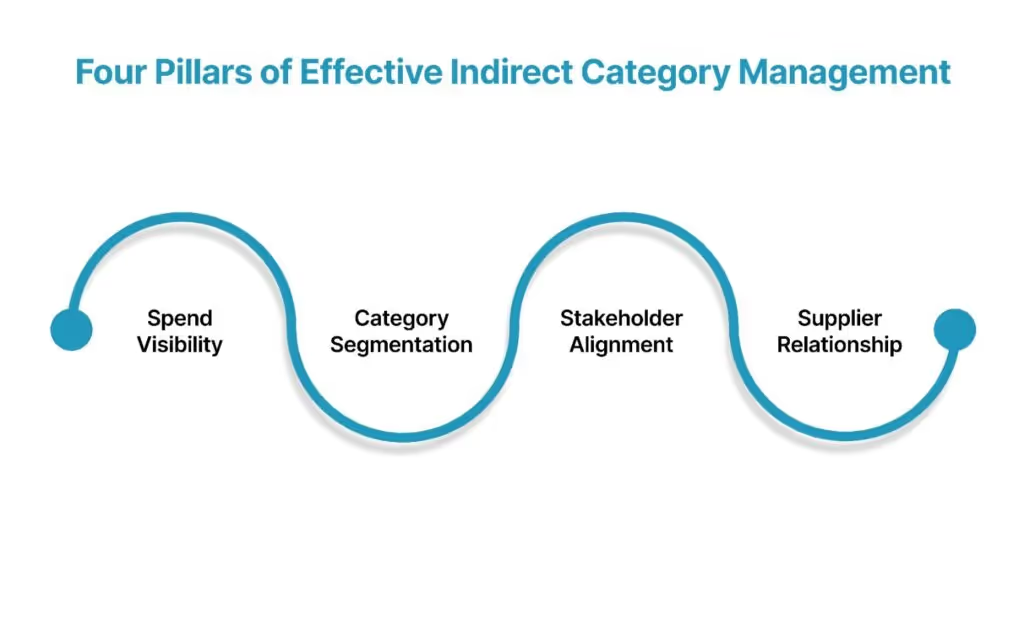
Die effektive Verwaltung indirekter Ausgaben beginnt mit einer soliden Grundlage, und hier kommen die vier wichtigsten Säulen des indirekten Kategorienmanagements ins Spiel.
Diese Säulen geben vor, wie Sie Ihre Beschaffungsmaßnahmen strukturieren, Stakeholder einbeziehen und messbare Ergebnisse im gesamten Unternehmen erzielen.
Hier ist, worauf Sie sich konzentrieren sollten:
1. Geben Sie Sichtbarkeit aus
Du kannst nicht verwalten, was du nicht siehst. Ein vollständiger Überblick über Ihre indirekten Ausgaben ist unerlässlich, um Einsparmöglichkeiten zu identifizieren, die Einhaltung der Vorschriften zu verfolgen und Verschwendung zu vermeiden. Verwenden Sie zentralisierte Beschaffungsplattformen, Echtzeit-Dashboards und Analytik ausgeben um zu kartieren, wohin Ihr Geld fließt und warum.
2. Kategorie Segmentierung
Gruppieren Sie ähnliche Produkte und Dienstleistungen in strategische Kategorien, um sie effektiver zu verwalten. Auf diese Weise können Sie Beschaffungsstrategien maßschneidern, Lieferanten konsolidieren und kategoriespezifische Benchmarks anwenden. Segmentierung erleichtert auch die Identifizierung von Bereichen mit hohem Einsparpotenzial oder Beschaffungsrisiko.
3. Abstimmung der Interessengruppen
Indirekte Beschaffung umfasst oft mehrere Abteilungen, jede mit ihren eigenen Bedürfnissen und Zielen. Interne Abstimmung Interessengruppen Zu einem frühen Zeitpunkt des Kategorieplanungsprozesses wird die Zustimmung gewährleistet, der Widerstand gegen Änderungen verringert und die Einhaltung der Vorschriften verbessert. Die Zusammenarbeit zwischen Finanz-, IT-, Marketing- und anderen Abteilungen ist entscheidend, um Konsistenz zu erreichen und Ergebnisse zu erzielen.
4. Management der Lieferantenbeziehungen
Strategisch Lieferantenpartnerschaften führen zu besserem Service, besseren Preisen und Innovationen. Konzentrieren Sie sich darauf, langfristige Beziehungen zu vertrauenswürdigen Lieferanten aufzubauen, die Leistung anhand von KPIs zu verfolgen und regelmäßige Überprüfungen durchzuführen. Dies trägt dazu bei, Risiken zu reduzieren und mehr Wert zu erschließen, der über reine Kosteneinsparungen hinausgeht.
Nachdem Sie nun eine solide Grundlage geschaffen haben, schauen wir uns die wichtigsten Strategien an, um indirekte Kategorien effektiver zu verwalten.
Top-Strategien für indirekte Kategorien
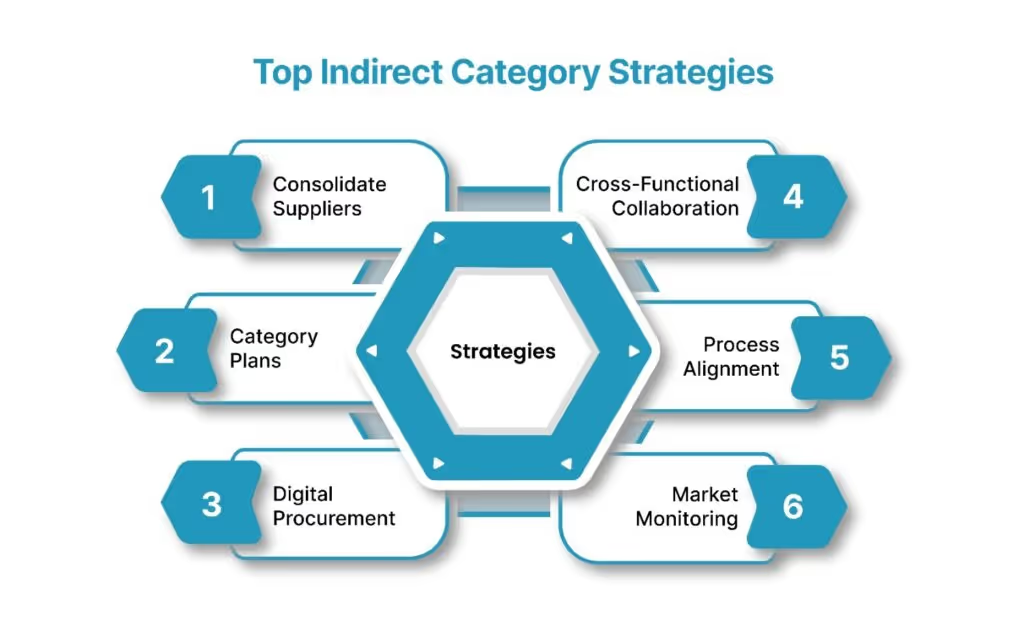
Sobald Sie die Kernpfeiler des indirekten Kategorienmanagements festgelegt haben, ist es an der Zeit, sie mit bewährten Strategien in die Tat umzusetzen, die zu Ergebnissen führen. Ziel ist es, die Komplexität zu reduzieren, die Kosten zu kontrollieren und langfristigen Mehrwert zu erschließen, ohne Ihre Teams auszubremsen.
Hier sind die wichtigsten Strategien, um indirekte Kategorien effektiver zu verwalten:
1. Lieferanten konsolidieren
Optimieren Sie Ihre Lieferantenbasis, indem Sie Einkäufe bei bevorzugten Anbietern konsolidieren. Dies erhöht Ihre Verhandlungsmacht, reduziert den Verwaltungsaufwand und führt häufig zu besseren Preisen und Serviceniveaus.
Lesen Sie auch Was ist Lieferantenbeschaffung? Ein Leitfaden für intelligentere Lieferentscheidungen
2. Implementieren Sie maßgeschneiderte Kategoriepläne
Jede indirekte Kategorie hat ihre Nuancen. Entwickle kategoriespezifisch Beschaffung Strategien, die die Marktlandschaft, die Binnennachfrage und die Fähigkeiten der Lieferanten widerspiegeln.
Zum Beispiel, Ihre Strategie für IT-Dienstleistungen sollte sich von der für Büromaterial oder Reisen unterscheiden.
3. Nutzen Sie digitale Einkaufstools
Verwenden Sie KI-gestützte Plattformen, Esourcing-Tools und automatisierte Workflows, um Ausgabendaten zu zentralisieren, die Leistung Ihrer Lieferanten zu verfolgen und die Konsistenz zu verbessern. Diese Tools verbessern die Transparenz, beschleunigen Genehmigungen und minimieren Fehler während des gesamten Beschaffungszyklus.
4. Funktionsübergreifend zusammenarbeiten
Indirekte Kategorien betreffen mehrere Abteilungen. Stimmen Sie die Beschaffung mit den Stakeholdern aus den Bereichen Finanzen, Personal und Betrieb ab, um sicherzustellen, dass die Strategien sowohl den funktionalen Anforderungen als auch den Geschäftszielen entsprechen.
5. Standardisieren Sie Richtlinien und Prozesse
Entwickeln Sie klare Beschaffungsrichtlinien, Vertragsvorlagen und Beschaffungsrichtlinien, um externe Ausgaben zu reduzieren und die Einhaltung der Vorschriften sicherzustellen. Die Standardisierung unterstützt auch die Skalierbarkeit, wenn Ihr Unternehmen wächst.
6. Überwachen Sie Markttrends und Benchmarking
Bleiben Sie über kategoriespezifische Marktveränderungen, Preisbenchmarks und Leistungskennzahlen für Lieferanten auf dem Laufenden. Dies hilft Ihnen, fundiertere Beschaffungsentscheidungen zu treffen und Ihre Strategien in Echtzeit anzupassen.
Um die Wirksamkeit dieser Strategien zu verfolgen, untersuchen wir die wichtigsten Leistungsindikatoren (KPIs), die gemessen werden sollten.
Wichtige Einkaufs-KPIs zur Erfolgsmessung des indirekten Kategorienmanagements
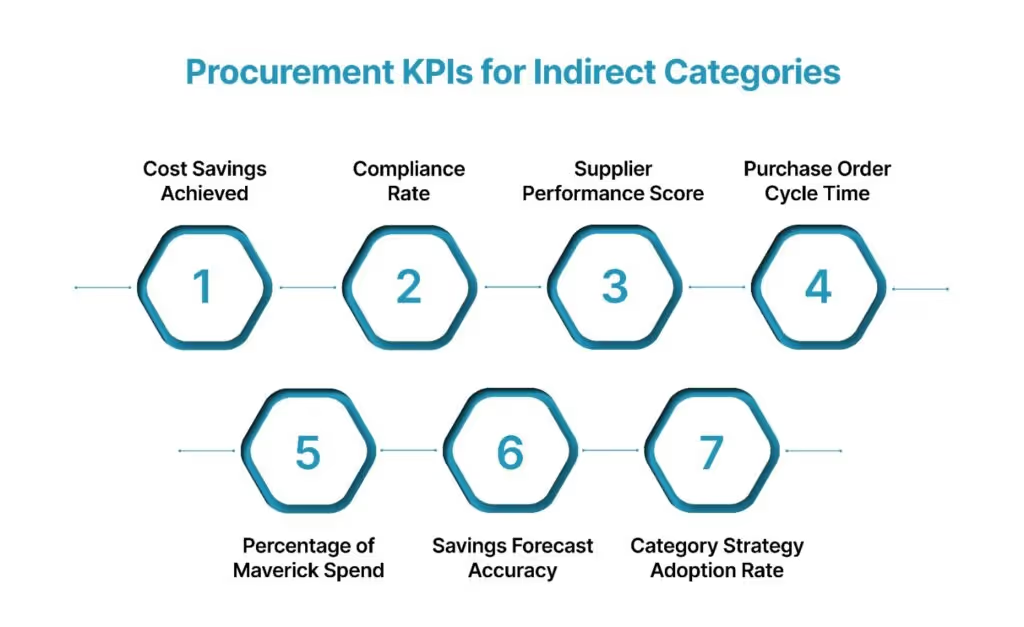
Dem Richtigen auf der Spur wichtige Leistungsindikatoren (KPIs) ist entscheidend, um festzustellen, ob Ihre Strategien für indirekte Kategorien wirksam sind. Ohne Kennzahlen ist es schwierig, den Wert nachzuweisen, Ihre Bemühungen zu optimieren oder Bereiche zu identifizieren, in denen Verbesserungen möglich sind. KPIs helfen Ihnen, die Verantwortung zu behalten, kontinuierliche Verbesserungen voranzutreiben und die Beschaffung an den Geschäftszielen auszurichten.
Hier sind die wichtigsten Einkaufs-KPIs, die Sie für das indirekte Kategoriemanagement verfolgen sollten:
- Erzielte Kosteneinsparungen: Messen Sie sowohl harte Einsparungen (z. B. ausgehandelte Rabatte) als auch weiche Einsparungen (z. B. Prozessverbesserungen). Dieser KPI spiegelt direkt die finanziellen Auswirkungen Ihrer Beschaffungsstrategien wider.
- Konformitätsrate: Überwachen Sie die Häufigkeit, mit der die Abteilungen die Listen bevorzugter Lieferanten, die Einkaufsrichtlinien und die Vertragsbedingungen einhalten. Eine höhere Einhaltung der Vorschriften bedeutet weniger unseriöse Käufe und eine bessere Kostenkontrolle.
- Leistungsbewertung des Lieferanten: Verwenden Sie Scorecards, um die Zuverlässigkeit, Qualität und Lieferzeiten von Lieferanten zu bewerten. Wenn Sie dies überwachen, stellen Sie sicher, dass Sie das Beste aus Ihren Lieferantenbeziehungen herausholen.
- Zykluszeit der Bestellung (PO): Messen Sie die Zeit, die von der Anforderung bis zur Genehmigung der Bestellung vergangen ist. Kürzere Zyklen bedeuten eine effizientere Beschaffungsprozess und weniger innere Reibung.
- Prozentsatz von Maverick Spend: Dies gibt den Betrag der Ausgaben an, die außerhalb der genehmigten Beschaffungskanäle getätigt werden. Ein niedrigerer Prozentsatz signalisiert eine stärkere Prozessdisziplin und eine bessere Ausgabenkontrolle.
- Genauigkeit der Prognose von Einsparungen: Vergleichen Sie die erwarteten und tatsächlichen Einsparungen durch Beschaffungsinitiativen. Präzise Prognosen spiegeln ein fundiertes Verständnis der Ausgabendaten und des Lieferantenverhaltens wider.
- Akzeptanzrate der Kategoriestrategie: Verfolgen Sie die Konsistenz, mit der interne Teams Kategoriepläne verabschieden und umsetzen. Eine hohe Akzeptanz zeigt, dass sich die Interessengruppen an einem Strang ziehen und dass sie der strategischen Rolle des Beschaffungswesens vertrauen.
Um diese KPIs konsistent zu erreichen, müssen Sie in die Entwicklung der internen Fähigkeiten investieren, die strategische, datengestützte Beschaffungsentscheidungen ermöglichen.
So bauen Sie interne Fähigkeiten für exzellentes indirektes Category Management auf
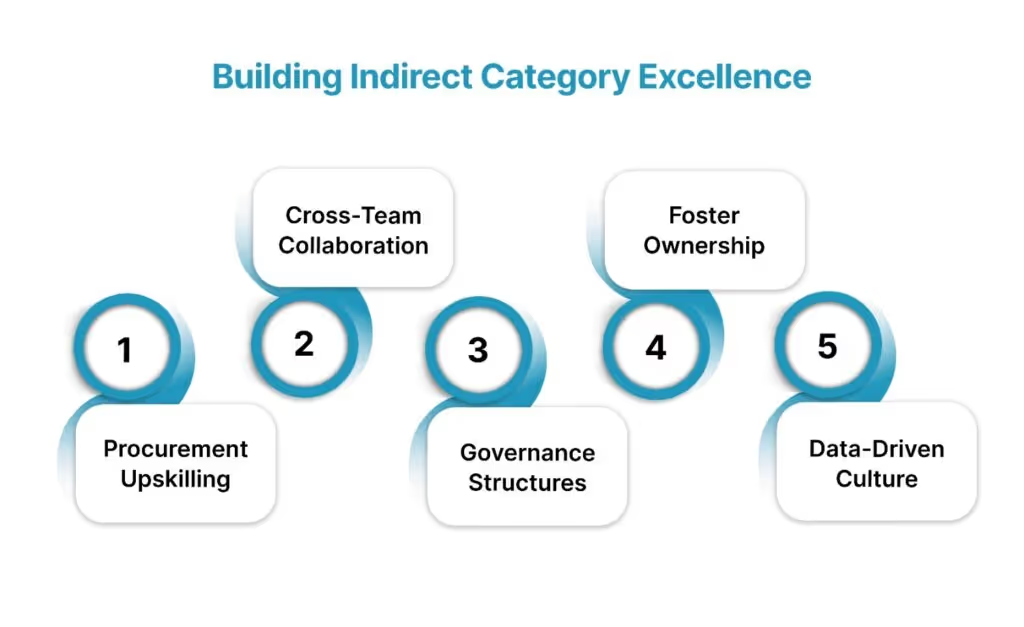
Starke Technologie kann Ihre Strategie unterstützen, aber es sind Ihre Mitarbeiter und Prozesse, die sie erfolgreich machen. Der Aufbau interner Fähigkeiten ist unerlässlich, um das indirekte Kategorienmanagement zu skalieren und den langfristigen Wert zu steigern. Wenn Ihr Team die strategische Bedeutung indirekter Ausgaben versteht und über die notwendigen Fähigkeiten und Strukturen verfügt, um diese effektiv zu verwalten, fördern Sie eine Kultur der kontinuierlichen Verbesserung und Rechenschaftspflicht.
So bauen Sie dauerhafte interne Kapazitäten auf:
1. Qualifizierung der Beschaffungsteams: Investieren Sie in Schulungen, die Ihre analytischen Fähigkeiten, Marktforschungsfähigkeiten und Verhandlungstaktiken für Lieferanten verbessern. Rüsten Sie Ihr Team aus, um komplexe indirekte Kategorien souverän zu verwalten.
2. Richten Sie eine funktionsübergreifende Zusammenarbeit ein: Indirekte Ausgaben betreffen alle Abteilungen. Richten Sie Lenkungsausschüsse oder Einkaufsräte ein, denen Finanzen, Personal, IT und Betrieb angehören, um die Einkaufsprioritäten an den Geschäftsanforderungen auszurichten.
3. Entwickeln Sie klare Führungsstrukturen: Definieren Sie Rollen, Verantwortlichkeiten und Genehmigungsworkflows für die Verwaltung indirekter Ausgaben. Eine klare Unternehmensführung gewährleistet Konsistenz, Compliance und eine bessere Entscheidungsfindung.
4. Förderung der Inhaberschaft von Kategorien: Weisen Sie der Kategorie Leads zu, die für Strategie, Lieferantenleistung und Ergebnisse verantwortlich sind. Die Übertragung von Verantwortung erhöht die Rechenschaftspflicht und fördert ein tieferes Verständnis der Kategorienlandschaft.
5. Fördern Sie eine datengesteuerte Kultur: Ermöglichen Sie Ihren Teams, Ausgabendaten und Marktinformationen bei ihren täglichen Entscheidungen zu nutzen. Eine datengesteuerte Denkweise führt zu besseren Prognosen, einem besseren Risikomanagement und einer besseren Nachverfolgung der Lieferantenleistung.
Nachdem Ihr Team und Ihre Prozesse eingerichtet sind, ist es an der Zeit, die technologischen Voraussetzungen zu erkunden, die Ihre Strategie für das indirekte Kategorienmanagement zum Leben erwecken.
Die besten Technologieanbieter für intelligenteres indirektes Kategorienmanagement
Um indirekte Kategorien effektiv zu verwalten, benötigen Sie mehr als nur eine Strategie; Sie benötigen die richtige Technologie. Digitale Tools optimieren nicht nur die Beschaffung, sie ermöglichen Einblicke, automatisieren manuelle Aufgaben und helfen Ihnen, das Kategorienmanagement unternehmensweit zu skalieren.
Bei durchdachter Implementierung ermöglicht Technologie eine schnellere Entscheidungsfindung, eine bessere Zusammenarbeit und engere Lieferantenbeziehungen.
Hier sind die wichtigsten technologischen Voraussetzungen, die das indirekte Category Management unterstützen:
1. Spend Analytics-Plattformen
Verschaffen Sie sich in Echtzeit einen Überblick über Ihre indirekten Ausgaben, indem Sie Daten aus mehreren Systemen konsolidieren. Mithilfe von Tools zur Ausgabenanalyse können Sie Muster erkennen, Einsparmöglichkeiten identifizieren und die Leistung Ihrer Lieferanten vergleichen.
2. E-Sourcing- und RFX-Tools
Optimieren Sie Sourcing-Events wie RFQs, RFPsund Auktionen. Diese Plattformen fördern das Engagement der Lieferanten, beschleunigen Bewertungen und ermöglichen wettbewerbsfähigere Angebote.
3. Verwaltung des Vertragslebenszyklus (CLM)
Zentralisieren und automatisieren Sie die Erstellung, Genehmigung und Überwachung von Verträgen. CLM Systeme helfen Ihnen dabei, Risiken zu managen, die Einhaltung von Vorschriften sicherzustellen und kostspielige Vertragsausfälle oder Verlängerungen zu vermeiden.
4. Procure-to-Pay (P2P) -Lösungen
Durchgehend P2P Plattformen automatisieren den gesamten Prozess, von der Anforderung bis zur Zahlung, reduzieren die Zykluszeiten und verbessern die Kontrolle über indirekte Käufe.
5. Tools für das Lieferantenbeziehungsmanagement (SRM)
Mit diesen Tools können Sie die Leistung Ihrer Lieferanten überwachen, Risiken managen und strategische Partnerschaften fördern. Sie können KPIs verfolgen, Leistungsbeurteilungen planen und effizienter zusammenarbeiten.
6. KI und prädiktive Analytik
KI verbessert Prognosen, Tail-Spend-Management und strategische Beschaffung Entscheidungen. Mithilfe von Prognosemodellen können Sie Lieferantenrisiken und Marktveränderungen vorhersehen, bevor sie sich auf Ihren Betrieb auswirken.
Schauen wir uns an, wie akirolabs Sie beim indirekten Kategorienmanagement unterstützt, um diese technologischen Voraussetzungen wirklich in einer intelligenten, einheitlichen Lösung zusammenzubringen.
Wie akirolabs ein intelligenteres indirektes Kategorienmanagement ermöglicht
Indirektes Kategoriemanagement kann einer der Bereiche sein, die es im Einkauf am schwierigsten zu optimieren gilt. Oft ist er auf mehrere Abteilungen verteilt und auf viele Lieferanten verteilt. Herkömmliche Systeme haben mit Transparenz und Kontrolle zu kämpfen, aber Akirolabs bietet eine ausgeklügelte, KI-gestützte Lösung, die die Verwaltung indirekter Ausgaben vereinfacht und transformiert, sodass Unternehmen die volle Kontrolle über ihre Beschaffungsstrategien erlangen können.
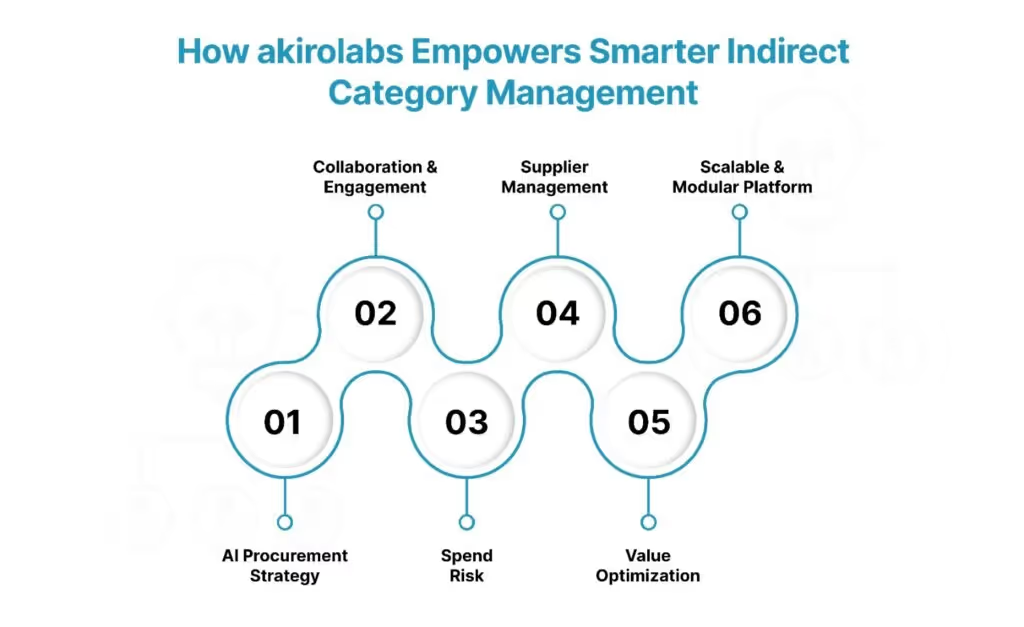
So geht's Akirolabs unterstützt intelligenteres indirektes Kategorienmanagement:
- KI-gestützte Beschaffungsstrategie
Mit akirolabs werden indirekte Ausgaben durch KI-gestützte Erkenntnisse optimiert, wodurch intelligentere Beschaffungsstrategien gewährleistet werden. Im Gegensatz zu herkömmlichen Tools, die sich auf operative Aufgaben konzentrieren, bietet Akirolabs den Category Managern KI-gestützte Entscheidungstools, die auf der Grundlage historischer Daten und Marktinformationen umsetzbare Empfehlungen geben. Diese Funktion hilft Ihnen dabei, Möglichkeiten zur Ausgabenoptimierung zu identifizieren, Lieferantenrisiken zu reduzieren und die Effizienz Ihrer indirekten Beschaffungsaktivitäten zu steigern.
Die KI-Engine der Plattform wurde entwickelt, um die menschliche Intelligenz zu erweitern und schnellere, datengestützte Entscheidungen zu ermöglichen, ohne die nuancierten Entscheidungen zu ersetzen, die für die Beschaffung erforderlich sind.
- Funktionsübergreifende Zusammenarbeit und Einbindung von Stakeholdern
An der indirekten Beschaffung sind häufig verschiedene Interessengruppen aus Abteilungen wie IT, Marketing, Finanzen und Personalwesen beteiligt, was die Ausrichtung der Strategie erschweren kann. Akirolabs erleichtert die Zusammenarbeit zwischen diesen Abteilungen, indem es zentralisierte Arbeitsbereiche und gemeinsame Dashboards anbietet. Diese Integration stellt sicher, dass alle Abteilungen auf die Beschaffungsstrategien abgestimmt sind, wodurch Silos reduziert und der Entscheidungsprozess beschleunigt wird.
Die Tools der Plattform für die Zusammenarbeit mit Stakeholdern stellen sicher, dass Sie während des gesamten Kategorienplanungsprozesses Beiträge von den relevanten Teams einholen können, wodurch die Einhaltung der Vorschriften verbessert und die Strategieentwicklung effizienter und inklusiver gestaltet wird.
- Ausgabentransparenz und Risikomanagement
Eine vollständige Ausgabentransparenz ist für ein effektives indirektes Kategoriemanagement von entscheidender Bedeutung, und akirolabs stellt sicher, dass Sie einen klaren Überblick über Ihre Beschaffungslandschaft in Echtzeit haben. Mit seinen integrierten Tools zur Ausgabenanalyse und zum Risikomanagement konsolidiert Akirolabs Ausgabendaten aus mehreren Systemen, sodass Ineffizienzen und potenzielle Einsparmöglichkeiten leichter erkannt werden können. Die Funktionen der Plattform zur Risikobewertung, einschließlich Risikobewertung für Lieferanten und Markttrendanalysen, ermöglichen es Ihnen, Risiken in der gesamten Lieferkette proaktiv zu identifizieren und zu mindern und so belastbare Beschaffungsentscheidungen auch in volatilen Zeiten zu gewährleisten.
- Lieferantenbeziehungs- und Leistungsmanagement
Einer der Hauptvorteile von Akirolabs ist die Fähigkeit, langfristige Lieferantenbeziehungen zu unterstützen. Die Plattform ermöglicht die Nachverfolgung der Lieferantenleistung und ein kollaboratives Beziehungsmanagement und ermöglicht es Ihnen, leistungsstarke Lieferanten zu identifizieren und strategische Partnerschaften aufzubauen, die zu verbesserten Preisen, Serviceniveaus und Innovationen führen. Akirolabs zentralisiert Informationen zur Lieferantenleistung und erleichtert so die Durchführung kontinuierlicher Lieferantenüberprüfungen, verbessert die Zusammenarbeit und optimiert die Lieferantenbasis.
- Wertverfolgung und kontinuierliche Verbesserung
Bei akirolabs geht die Messung des Einkaufserfolgs über Einsparungen hinaus. Wichtige Leistungsindikatoren (KPIs) wie Compliance-Raten, Lieferantenleistung und Sonderausgaben werden in Echtzeit verfolgt, sodass Sie den Erfolg Ihrer Strategien für indirekte Kategorien beurteilen können. Die Echtzeit-Tracking-Funktionen der Plattform ermöglichen es Ihnen, Ihre Strategien im Handumdrehen anzupassen und so sicherzustellen, dass Sie Ihre Einkaufsziele auch weiterhin erreichen. Die Value-Tracking-Tools von akirolabs ermöglichen es Teams, sowohl spürbare Einsparungen als auch weiche Einsparungen aus verbesserten Prozessen zu erfassen und so einen kontinuierlichen Geschäftswert zu erzielen.
- Skalierbare und modulare Plattform
Egal, ob es sich bei Ihrem Unternehmen um ein globales Unternehmen oder ein mittelständisches Unternehmen handelt, akirolabs bietet eine modulare, skalierbare Lösung, die sich an Ihre Bedürfnisse im Bereich der indirekten Beschaffung anpasst. Die No-Code-Konfiguration der Plattform gewährleistet eine einfache Bereitstellung in verschiedenen Beschaffungsteams, sodass kein umfassender IT-Support erforderlich ist. akirolabs lässt sich nahtlos an das Wachstum Ihres Unternehmens anpassen und ist somit die ideale Wahl für Unternehmen, die indirekte Ausgaben optimieren möchten, ohne die internen Ressourcen zu überlasten.
Sind Sie bereit, die Kontrolle über Ihre indirekten Ausgaben zu übernehmen? Buchen Sie noch heute eine Demo mit Akirolabs und erfahren Sie, wie unsere Plattform Ihnen helfen kann, schnell eine intelligentere Beschaffung, stärkere Lieferantenpartnerschaften und messbare Werte zu erzielen.
Fazit
Indirektes Category Management ist ein strategischer Imperativ. Wenn Sie indirekte Ausgaben bewusst verwalten, erzielen Sie mehr als nur Kosteneinsparungen. Sie verbessern die Transparenz, mindern Risiken, treiben Innovationen voran und fördern eine stärkere Abstimmung in Ihrem Unternehmen.
Indem Sie sich auf die richtigen Strategien, KPIs, internen Fähigkeiten und unterstützenden Technologien konzentrieren, können Sie aus einem traditionell übersehenen Bereich eine Quelle messbaren Geschäftswerts machen.
Jetzt ist es an der Zeit, von einer fragmentierten Beschaffung zu einem intelligenteren, datengesteuerten Ansatz überzugehen, der zu Ergebnissen führt.
Sie möchten Ihre Strategie für das indirekte Kategorienmanagement optimieren und skalieren?
Vereinbaren Sie noch heute eine Demo mit Akirolabs und entdecken Sie, wie unsere KI-gestützte Plattform Ihnen helfen kann, die indirekte Beschaffung in einen Wettbewerbsvorteil umzuwandeln.
Was macht ein erfolgreiches Pilotprojekt mit Akirolabs aus?
Wir definieren Erfolg gemeinsam mit Ihrem Team. Zu den typischen Ergebnissen gehören die Strategieerstellung für Prioritätskategorien, messbare Prozessverbesserungen und interne Abstimmung. Wir bieten volle Unterstützung und einen klaren Zeitplan für die Bewertung.
Kann ich die Plattform nach der Demo praktisch ausprobieren?
Ja, wir bieten geführte Piloten und Sandbox-Umgebungen an, je nachdem, in welcher Phase des Kaufprozesses Sie sich befinden. Diese geben dir und deinem Team die Möglichkeit, Funktionen in deinem eigenen Kontext zu erkunden.
Wer sollte an der Demo meiner Organisation teilnehmen?
Wir empfehlen, wichtige Stakeholder aus Ihrem Führungsteam für die Beschaffung, aus der Kategorie Management und aus den Gruppen für Exzellenz oder Transformation im Bereich Beschaffung einzubeziehen. Die Einbeziehung von Interessenvertretern aus dem Unternehmen kann auch hilfreich sein, um zu demonstrieren, wie die Plattform die funktionsübergreifende Zusammenarbeit erleichtert.
Was werde ich während einer Akirolabs-Demo sehen?
Während der Demo sehen Sie die komplette Akirolabs Category Strategy Workbench in Aktion, einschließlich des kollaborativen Workflows, der KI-gestützten Erkenntnisse von AkiroAssist, der Funktionen zur strategischen Szenariomodellierung und der Strategy One-Pager-Funktion. Wir passen die Demonstration so an, dass sie sich auf Aspekte konzentriert, die für die Bedürfnisse Ihres Unternehmens am relevantesten sind.
Kann ich sehen, wie Akirolabs mit unseren spezifischen Kategorien funktionieren würde?
Ja, wir können die Demo so anpassen, dass sie zeigt, wie Akirolabs mit Ihren spezifischen Kategorien und Ihrer Beschaffungsstruktur zusammenarbeitet. Teilen Sie uns Ihre Schwerpunktbereiche im Voraus mit und wir passen die Demonstration entsprechend an.
Wie lange dauert eine typische Demo?
Eine Standarddemo dauert etwa 45-60 Minuten und bietet ausreichend Zeit für einen umfassenden Überblick über die Plattform und eine Diskussion Ihrer spezifischen Anforderungen. Wir können den Zeitplan an Ihre Verfügbarkeit und Ihre Interessengebiete anpassen.
Sind Sie bereit, Ihre Beschaffungsstrategie zu transformieren?
Es gibt einen besseren Weg, die Beschaffung zu erledigen. Das ist IT.
.avif)







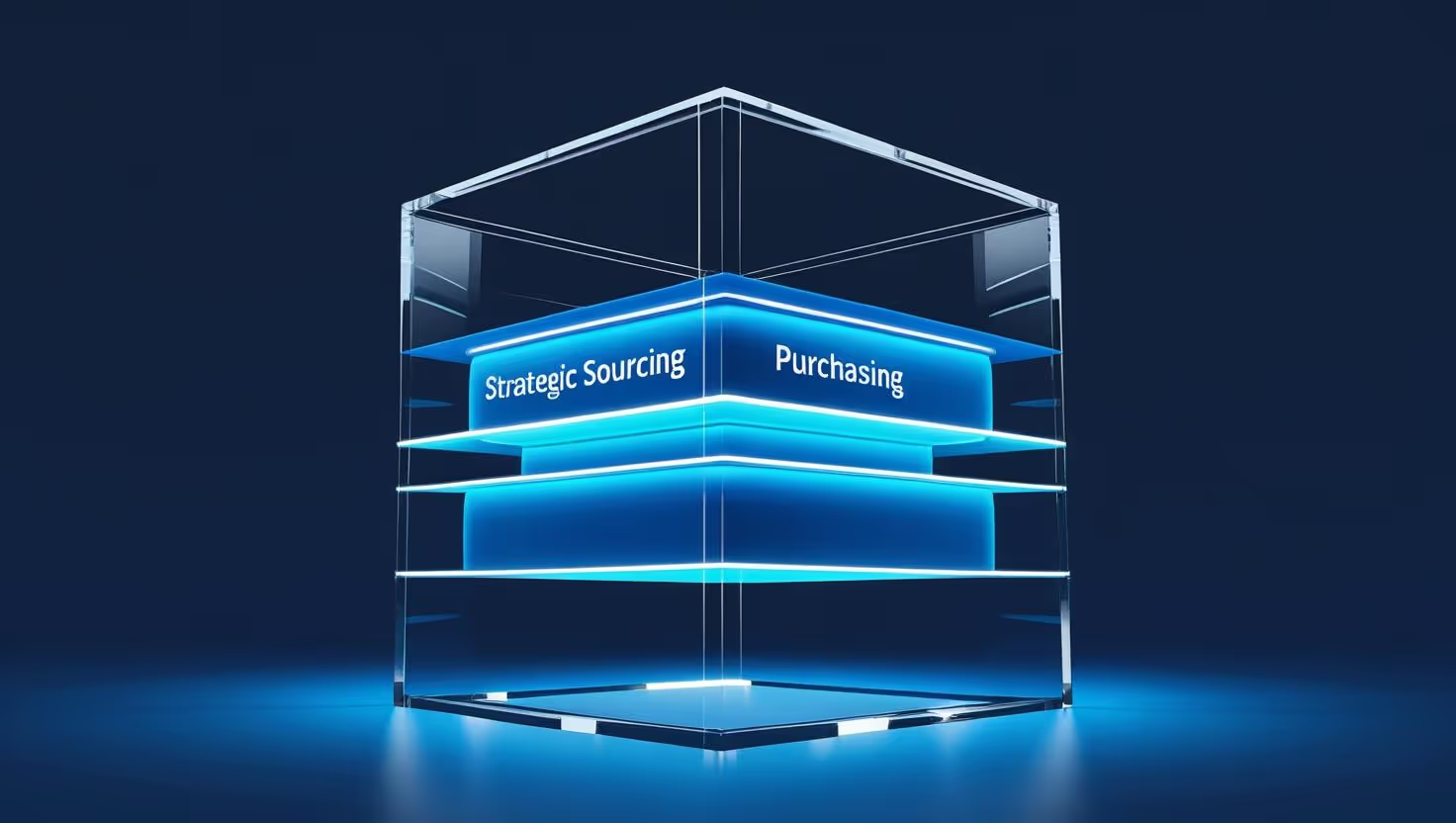
















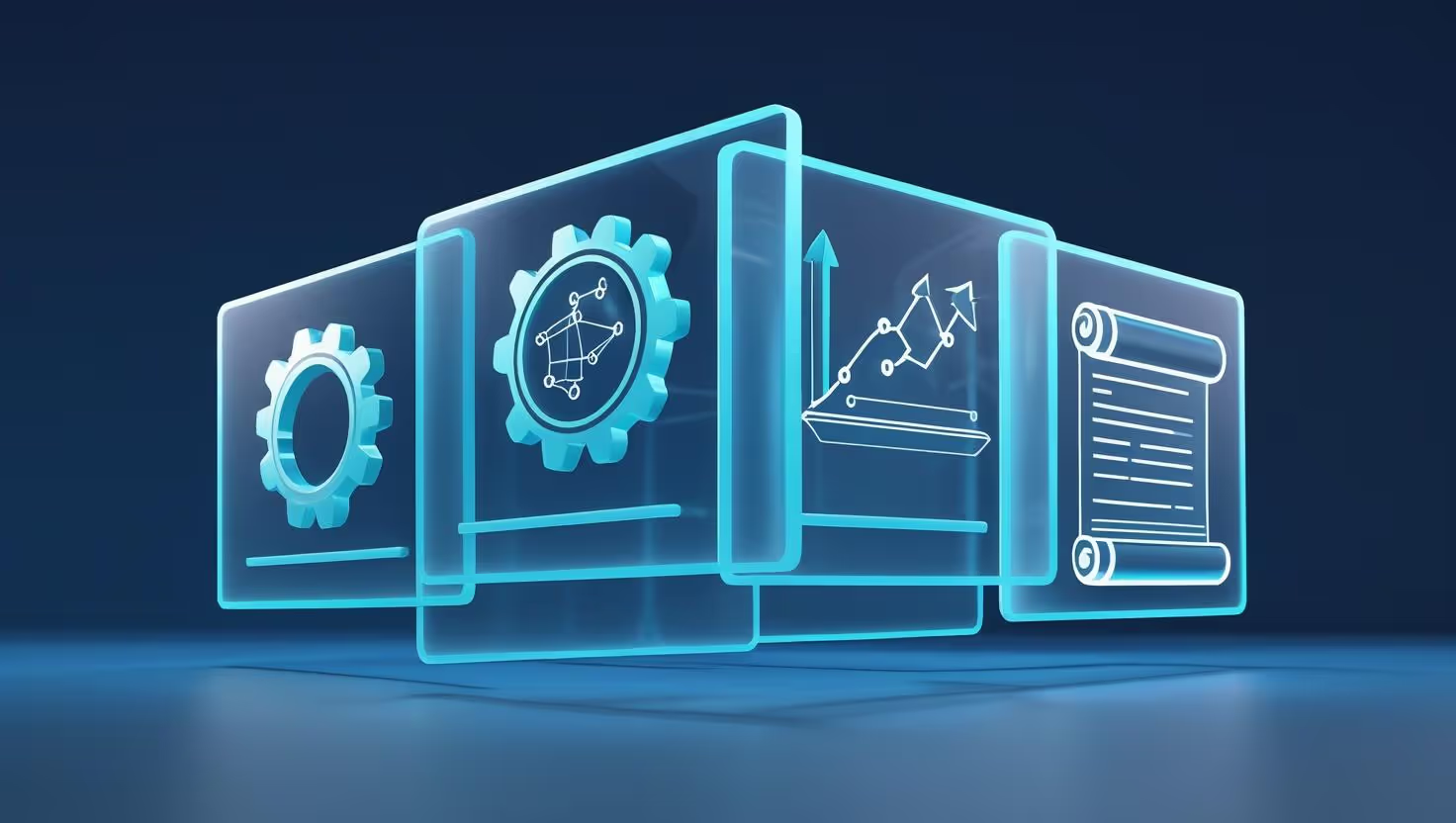













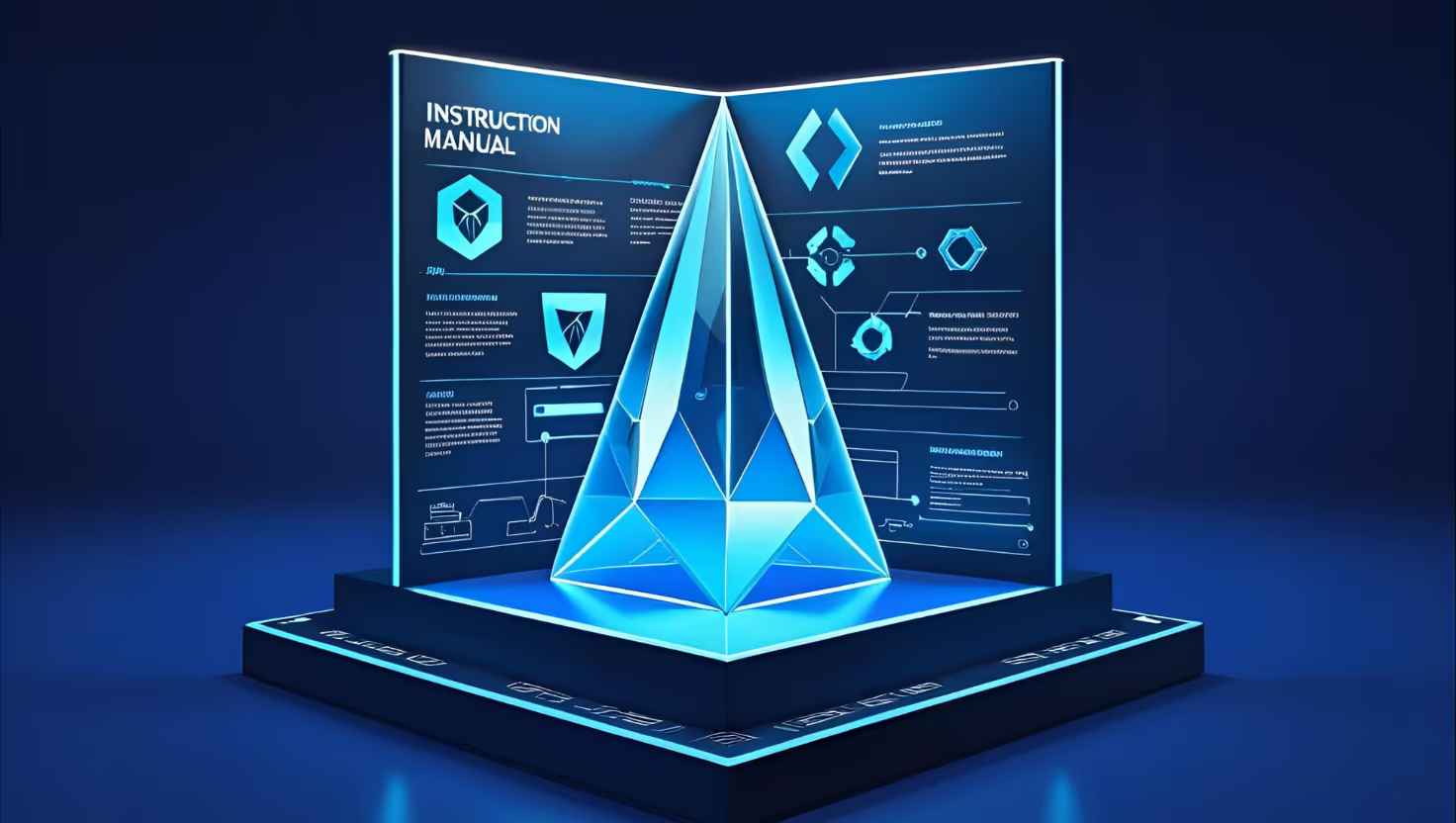




















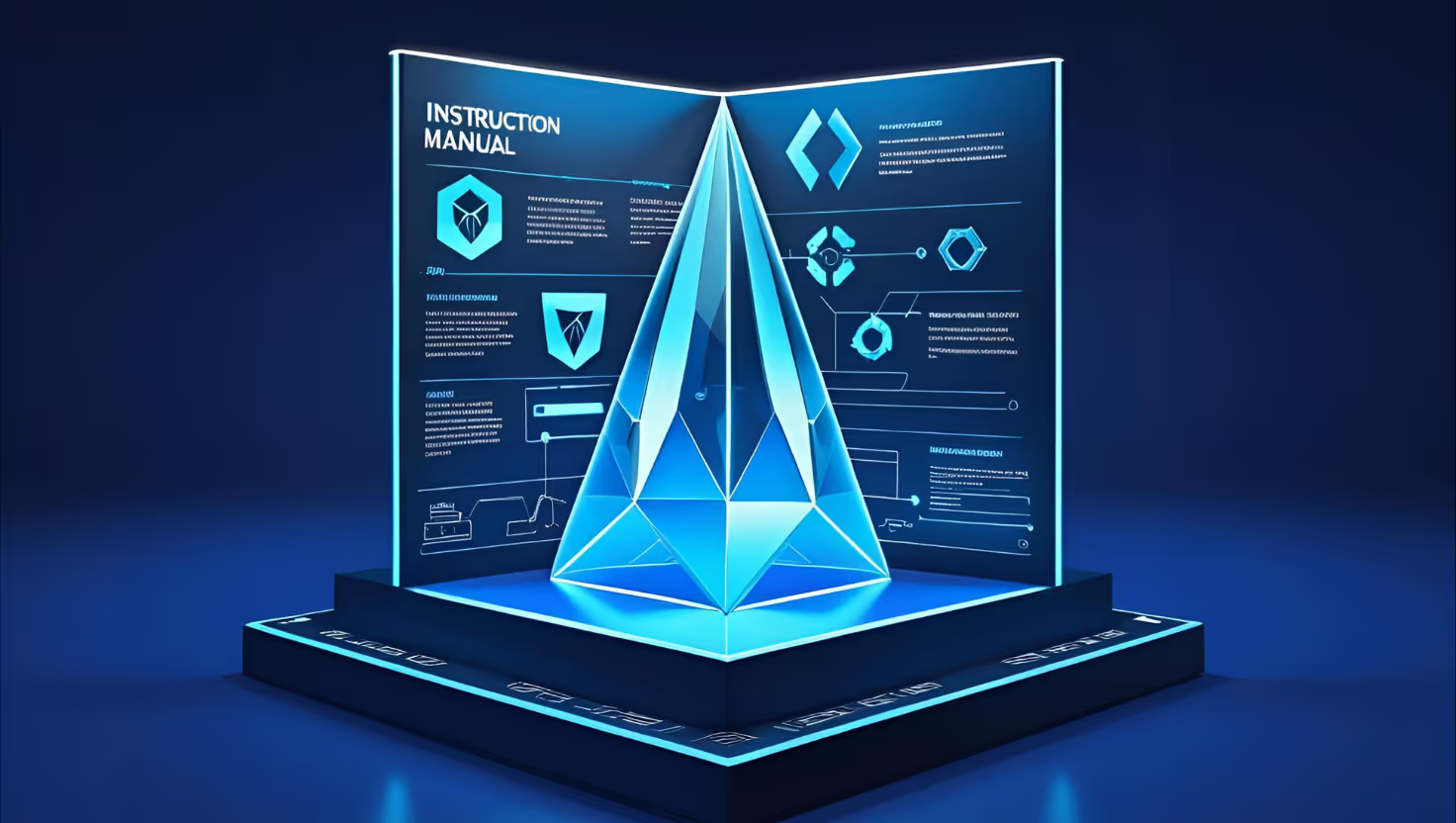










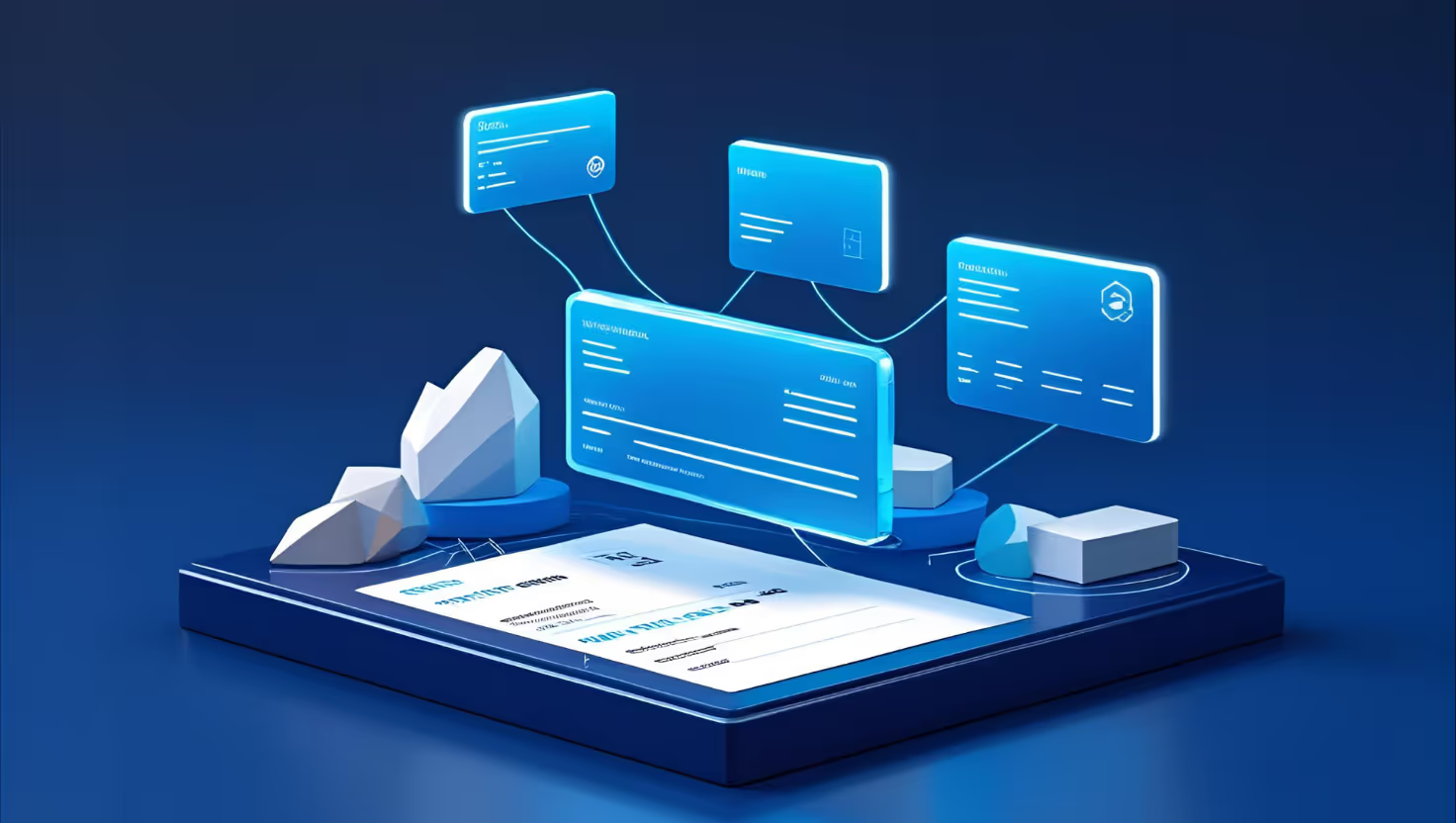














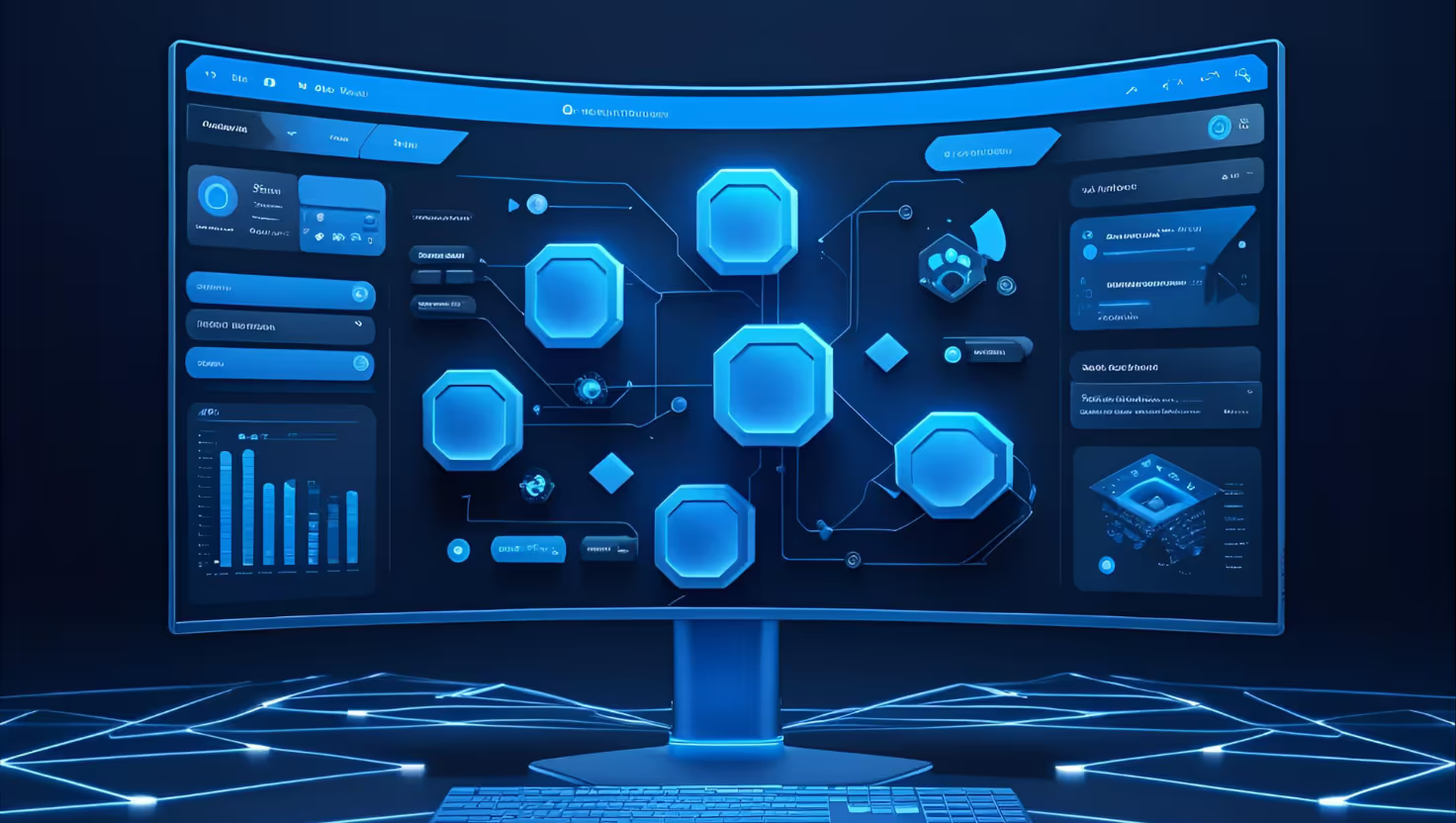












.avif)









